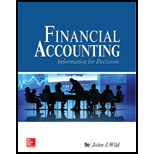
1.
Concept Introduction:
Accounting has formula that represents assets is equal to the liabilities plus owner’s equity. Each year owner’s equity is calculated by after reducing and adding the profit or loss of the year. Net Income or profit is calculated by reducing expenses from revenues.
To Calculate:
Return on assets.
2.
Concept Introduction:
Accounting has formula that represents assets is equal to the liabilities plus owner’s equity. Each year owner’s equity is calculated by after reducing and adding the profit or loss of the year. Net Income or profit is calculated by reducing expenses from revenues.
To Calculate:
Successful in total sales.
3.
Concept Introduction:
Accounting has formula that represents assets is equal to the liabilities plus owner’s equity. Each year owner’s equity is calculated by after reducing and adding the profit or loss of the year. Net Income or profit is calculated by reducing expenses from revenues.
To Calculate:
Successful in return over assets.
4.
Concept Introduction:
Accounting has formula that represents assets is equal to the liabilities plus owner’s equity. Each year owner’s equity is calculated by after reducing and adding the profit or loss of the year. Net Income or profit is calculated by reducing expenses from revenues.
To Calculate:
One paragraph on over which company is better for the option of investment.
Want to see the full answer?
Check out a sample textbook solution
Chapter 1 Solutions
Financial Accounting: Information for Decisions
 Financial Accounting: The Impact on Decision Make...AccountingISBN:9781305654174Author:Gary A. Porter, Curtis L. NortonPublisher:Cengage Learning
Financial Accounting: The Impact on Decision Make...AccountingISBN:9781305654174Author:Gary A. Porter, Curtis L. NortonPublisher:Cengage Learning Managerial Accounting: The Cornerstone of Busines...AccountingISBN:9781337115773Author:Maryanne M. Mowen, Don R. Hansen, Dan L. HeitgerPublisher:Cengage Learning
Managerial Accounting: The Cornerstone of Busines...AccountingISBN:9781337115773Author:Maryanne M. Mowen, Don R. Hansen, Dan L. HeitgerPublisher:Cengage Learning Cornerstones of Financial AccountingAccountingISBN:9781337690881Author:Jay Rich, Jeff JonesPublisher:Cengage Learning
Cornerstones of Financial AccountingAccountingISBN:9781337690881Author:Jay Rich, Jeff JonesPublisher:Cengage Learning





